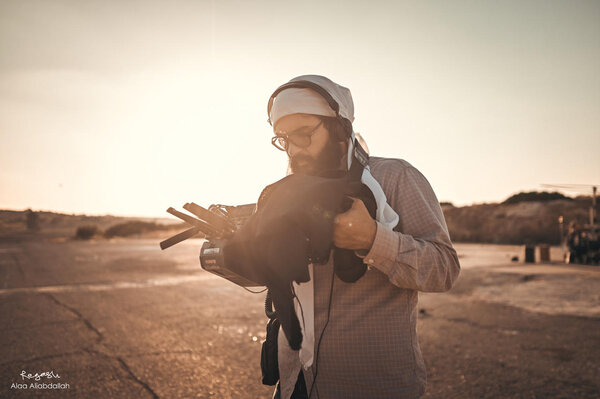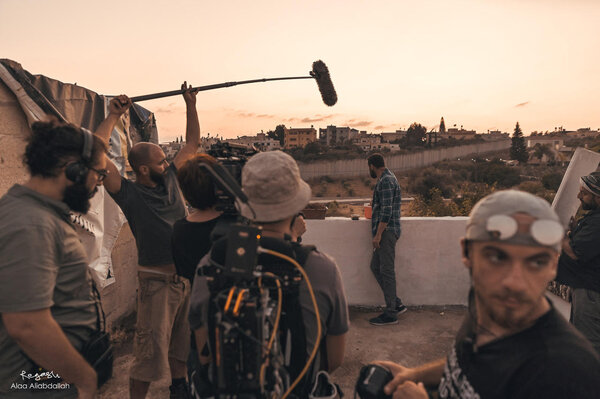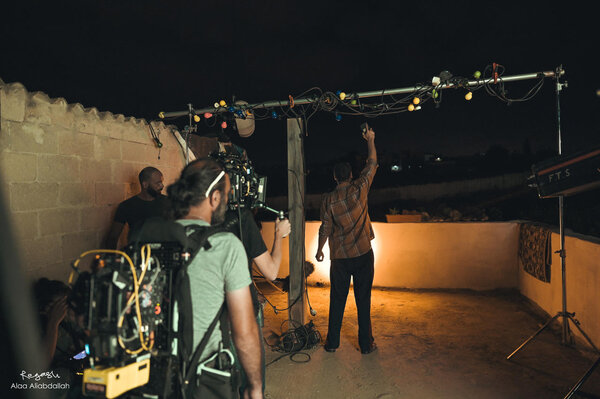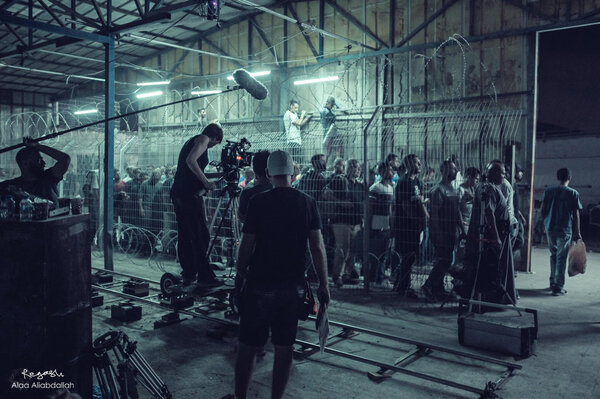Elin Kirschfink, SBC, AFC, discusses the challenges of shooting Ameen Nayfeh’s “200 Meters”
A frustrated road movieMustafa is on one side, Salwa and their children are on the other : a family lives separated by the Israeli border wall, only 200 meters away from one another. They practice daily resistance using the craftiness and tenderness required to “get along” like everyone else. But, one day, a serious incident upsets their delicate equilibrium. In order to get to his wounded son on the other side of the wall, the father begins an odyssey through checkpoints on a smuggler’s minibus where each person’s destiny collides with the most absurd obstacles.
Charmed by the depth of the screenplay, the cinematographer remembers discovering the project : “There was something extremely human about the project. Even though the things that happen are very serious, and are almost like a thriller, Ameen constantly maintains a humoristic undertone, and most importantly, she creates very endearing characters. That’s the primary criterion that determines my decision to take on a film. I absolutely must be in osmosis with the characters I am going to film. I have a very direct relationship with them, and particularly with the handheld camera style I often use. Therefore, I must be able to love them. And, in this screenplay, I loved them all !”

Produced with a very limited budget compared to the complexity of the film, Elin rapidly faced very short preproduction deadlines : “With only two weeks of preparation on location, and 24 days of shooting scheduled, I’ll admit that I did have my doubts about the actual feasibility of this project. Especially since I’m used to this down and dirty type of situation ! With so many movements, locations (and complicated setups required), I couldn’t really imagine how we were going to be able to shoot all of the sequences. But I let Ameen convince me, and I left for Palestine, with a desire to discover that country that I hadn’t been to before and where I probably would never go if it weren’t for a shoot. This was a way of discovering an area of the world where humanity’s affairs are going poorly, and it was a reason for me to spend some time there !” Once she arrived on location and began to prepare the film, Elin was confronted with her first unexpected happening : “The producer announced to me that shooting would take place in only 22 days. I tried to negotiate, arguing that the film couldn’t be done in such a short amount of time, but nothing could induce her to change her mind. We went about our location scouting while also working on bringing together as many locations as we could and simplifying the screenplay so that we would be able to make it work.”
In this film, fiction is close to reality (the film is partially autobiographical for the director), and the crew found itself stuck in a place where freedom of movement has become a utopic concept. “This is a film about the difficulty of coming and going in this very particular place. As soon as we began location scouting, we realized how true it was. Every trip, even an insignificant one according to our Western standards, suddenly took hours because of the geopolitical complexity. We were confronted with three zones in the country : colonized areas where only Israeli automobiles have the right to use the roads, mixed roads where checkpoints exist but where Palestinians are allowed to drive, and 100% Palestinian cities, where there is theoretically no control by the Israeli army. This is a true headache, because some checkpoints may close from one day to the next, or at certain times of the day, which suddenly blocks or slows down your trip. This situation is mentioned in the film but isn’t explained in detail. That is the scene at the mobile checkpoint in the middle of the road where the soldier asks the protagonists whether they like Palestinians. I can tell you how demoralizing this type of situation is. Being confronted with arbitrariness and hours of waiting in your daily life… In parallel, I was touched by the Palestinians’ extremely warm welcome, people were constantly inviting us to spend time in their homes, to have another glass of tea… The speed of scouting is definitely slower than elsewhere !”


One of the emblematic locations in the film is in the opening (and concluding) sequence, on a terrace directly overlooking the wall (sometimes constructed straight through some Palestinian vilages). The cinematographer remembers how hard it was to film that scene simply and with immediacy : “It was a true challenge to find an apartment with a terrace that had a view on the wall in which we’d be able to set up and film all of those scenes. Not that it’s an unusual or rare thing, but people are very afraid of a film shoot because the 24/7 video surveillance systems that control the perimeter of the wall make retaliation possible. So, we had to recompose the location, by using a terrace that overlooked the countryside and editing it together with shots we’d taken discreetly from the appropriate vantage point of the village of Zeita and the wall. A simple pillar and naked lightbulb (set up successively in two locations) lit by the character of Mustafa made it possible to match the shots on screen.”
Because Palestine isn’t easy to travel to, Elin had to take precautions not to endanger the producers : “Warned by Ameen, I’d taken the precaution of not bringing any documents related to the shoot on the plane with me. Indeed, when traveling through Tel Aviv, it’s possible to be turned away at the border if there is any suspicion that a foreign traveller intends to enter the Palestinian territories. Our gaffer, Léa Renaudet, and key grip, Ahmed Zaoui, who travelled after me, suffered from this, and spent several hours being interrogated by Israeli law enforcement. But they were allowed to enter, given that they had an official invitation from the French consulate in Jerusalem, which wasn’t my case.”
Especially because one of the most impressive scenes is literally shot without permission and is of one of the largest “crossing gates” in the country. This is a place that tens of thousands of people pass through daily in truly revolting conditions.
Especially because one of the most impressive scenes is literally shot without permission and is of one of the largest “crossing gates” in the country. This is a place that tens of thousands of people pass through daily in truly revolting conditions.
“It is an authentic and highly oppressive place, right next to Tulkarm, says Elin Kirschfink. At four a.m., every day, an unbelievable mass of people line up and wait to cross the border to go work. We were able to scout it out during the daytime, wearing hoods over our heads because of the countless surveillance cameras. We shot all of those shots in a single time, because we knew that if we got caught, we’d never be allowed back. Luckily, no one noticed the camera because everyone is so anxious to get through, it’s almost as though they were hypnotized by the ritual. I was carrying the camera by hand, with Ahmed in my side, in that sort of fenced in cattle area, with Ameen, the director, guiding the actor.

« The heart of the checkpoint, with the inspection zone and the customs agents, was filmed later on, in “studio”. Bashar, our set designer, had faithfully rebuilt (in spite of our limited means) the four successive inspection zones inside of a hangar, while a few extras were used to match the shots together. I think the sound and the images we captured in real-life conditions were very helpful for making those reconstructed scenes credible.”
Having discussed as a preliminary her warmhearted feelings towards the characters and the actors, Elin gave us some more details about how their relationship grew on 200 Meters : “As far as I’m concerned, it’s important to give them space to act, by not overwhelming them with too much equipment. Because a large part of the film took place in vehicles, the art of choreography that often develops when filming actors with a handheld camera, was less significant on this film. After all, this is a particular sort of road movie in one of the rare countries in the world where it is nearly impossible to get around ! That feeling of confinement, of claustrophobia, grows on screen as the thriller part of the film comes together. Or, it’s about how to portray confinement in a road movie, a genre in which freedom of movement is normally taken for granted.”
Compactness, discreetness, and rapidity : the DoP discusses her equipment choices on this film : “Because we had to be most comfortable in the car scenes, I was able to get my hands on a Sony Venice outfitted with a remote head. The camera body was set up in a backpack, which allowed me total freedom in setting it up. In terms of lenses, I composed my own assemblage of Zeiss Wide Angle lenses from 4 different series. I did this in order to obtain the right relationship of flares and minor imperfections that might counterbalance the camera’s very high definition. Later on, a slight amount of grain was added in postproduction to break the smooth quality of the image. Most of the time, I shot at 500 ISO, because I prefer the result at that sensitivity in 4K. But, that didn’t stop me from increasing sensitivity when needed. In the end, by shooting the night scenes at full aperture and, with the help of my excellent focus puller, Ashraf, 500 ISO were enough.
E In terms of lighting and grip equipment, it was also important to find the least cumbersome options :
“For the car interiors, we used a combination of simple techniques. The producers had insisted on bringing my key grip from France, whose experience and equipment proved decisive during editing. Amongst the most important choices, were the smuggler’s van, in which a lot of the scenes took place, with a lot of people. We were able to find a model of van with a ceiling high enough to be able to hide a 90x90 LED panel. This was absolutely necessary, given the extreme contrast with the exterior. Almost all day scenes were filmed with a handheld camera or with the head in the car, or with the camera attached to the outside of the car and the actors driving the car themselves. For the night scenes at the end of the film in the car, and the fake checkpoint to get into Israel, we shot using a heavier configuration : a car towed by a pickup truck, with a set of Asteras we brought in from Tel Aviv.
In retrospect, what has she taken away from this film shoot ? “The people I met, of course, and the amount of letting go I had to do. When you’re working on a film like this, which seems almost impossible to make at first glance, you think a lot about what our cinematographer’s profession really means. Giving birth to someone else’s film is what I think it’s really all about. Solving technical problems, playing a role in the telling of a story I believe in, while maintaining visual coherency. That’s where experience and feeling are most fundamentally important.”
(Interview by François Reumont, for the AFC – Translated from French)
200 mètres
Producer : May Odeh – Odeh Film
Director : Ameen Nayfeh
Set Design : Bashar Hassuneh
 En
En Fr
Fr





